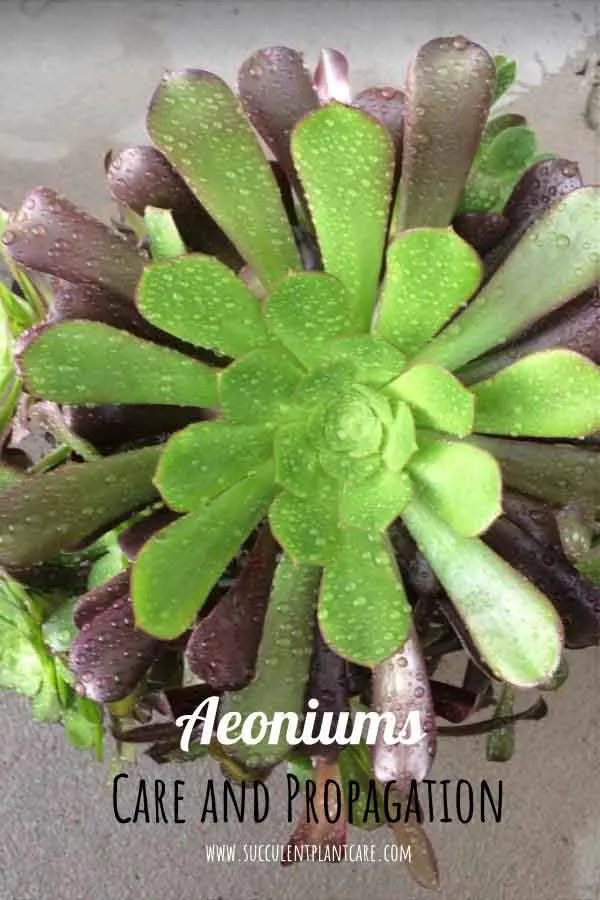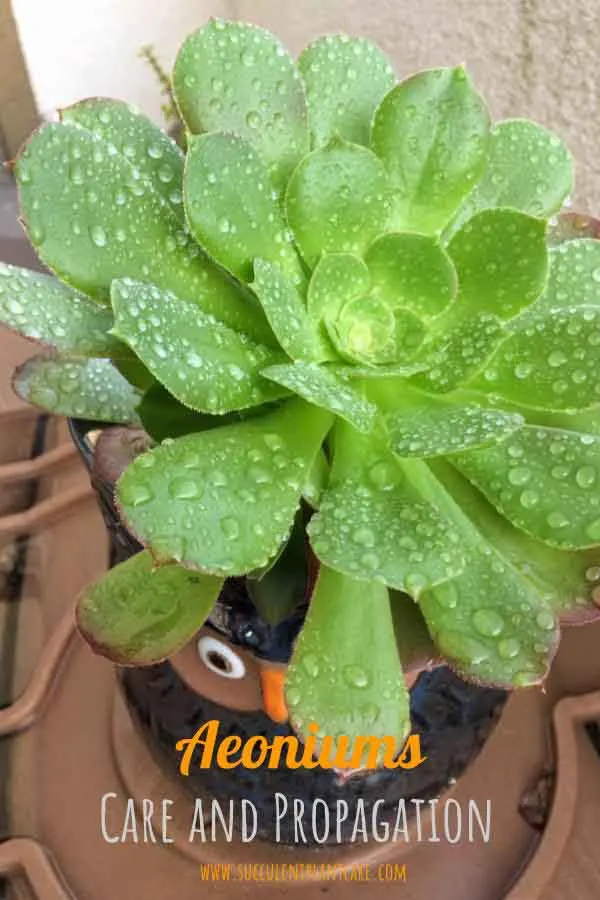The very first time I heard about aeoniums was the day I was given three aeonium stem cuttings from a coworker. She didn’t tell me much about them except to plant them in soil.
She didn’t even know what they were called but she did mention she had them growing everywhere in her garden and that they are very easy plants. I quickly learned that aeoniums are a genus of succulent plants.
If you are not too familiar with aeoniums, you’ve come to the right spot. I have come to know and love aeoniums for their unique qualities and unusual features. They have become one of my go-to succulent plants and use them for pretty much anything. They really are easy plants and have lived up to their reputation.

What Are Aeoniums?
Most aeoniums are native to the Canary Islands; some are found in Madeira, Morocco and East Africa. Aeoniums are most commonly known for their striking rosettes made up of dense, waxy leaves growing out of a single stem. Stems can be long and branched-out or short and stubby.
A unique feature of aeoniums is the way they grow and branch out. They reproduce and form offsets from a single flowerhead. New offsets emerge and branch out from a single flowerhead which then dies after producing several offsets. The death of one flowerhead goes unnoticed because of the many offsets it produces.
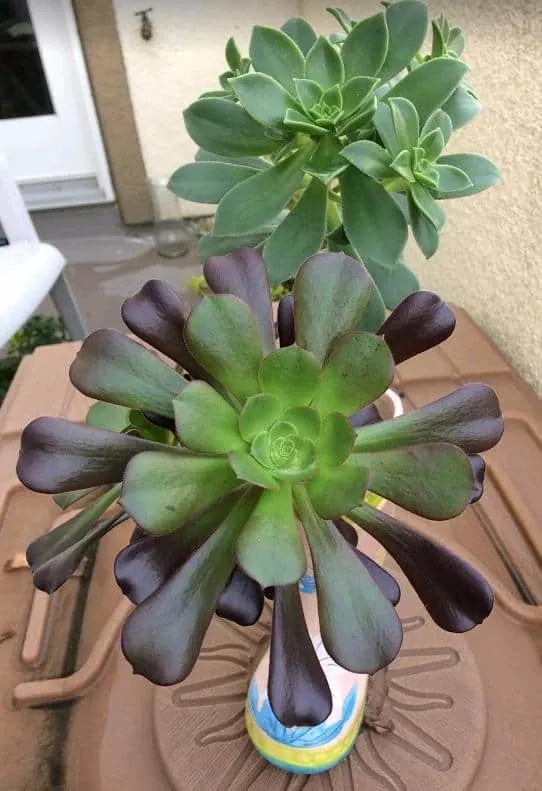
Aeoniums come in a number of varieties, colors, shapes and sizes. Most aeoniums are monocarpic plants, meaning they die once they produce a flower. Aeoniums are hardy plants and can withstand cold. They grow best in full sun to partial shade.
Aeoniums go dormant in really hot and dry weather conditions. Their leaves will curl and drop to prevent excessive water loss. Unlike some succulent plants, their true growth period is during winter or spring. Aeoniums can be grown in ground or in containers.
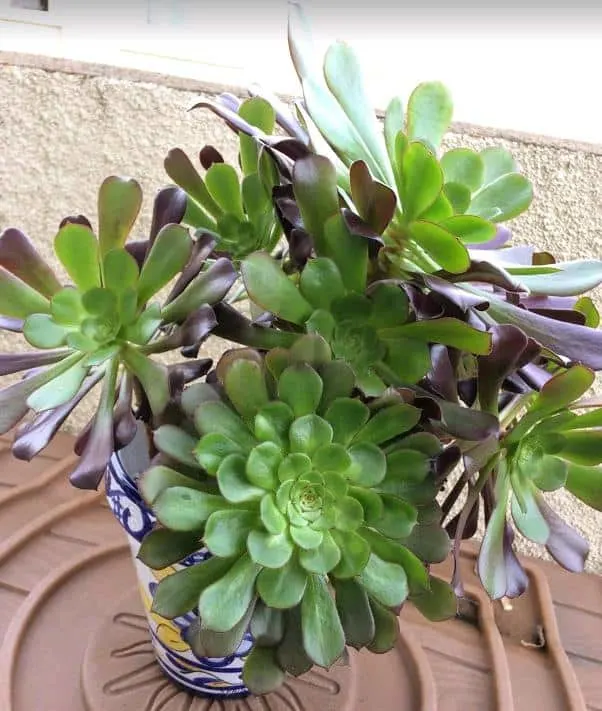
Aeonium Care
Are Aeoniums Indoor or Outdoor Plants?
Aeoniums can be grown both indoors and outdoors, either as container plants or in ground. Whether indoors or outdoors, provide a suitable well draining potting mix to give them the best chance at survival. I keep all of my aeoniums outdoors and they are growing happily.
We have mild winters here in Northern California and I leave them outside all year. They tolerate mild frost and even freezing temperatures. Some aeonium species are more frost tolerant than others.
Soil
Just like with other succulent plants, Aeoniums need a well draining soil. I like to use a cactus potting mix combined with perlite for added drainage. I do not use exact measurements but eyeball it to about 1:1 solution of cactus mix and perlite. Others recommend using a sandy soil.
This can be achieved by mixing cactus mix or potting soil with coarse sand (about 2:1 ratio). Or you can use a combination of potting mix, coarse sand, perlite or pumice. To find out more about soil for succulents and different materials to use, please read my post “Best Soil and Fertilizers for Succulents”. If you need help finding these materials online, you can find them easily on my resource page.
Watering
Watering largely depends on the climate you live in. Watering schedule is determined by the season, the weather and humidity in your area. I live in a very dry climate so my watering schedule is adapted to the dry conditions of my environment. In the summer, during intense heat, I water my aeoniums every 7-10 days, giving them a good drink. I cut back on watering to about 10-14 days when the weather cools down.
If you live in a humid location, you won’t need to water as much. During winter season, I mostly rely on rainwater and hold back on watering altogether because this is when we get a lot of rain in my area. But if we don’t get any rain at all during winter I water at least once every 2-3 weeks.
Aeoniums in particular love the rain during winter. This is when they look their best and plump up and grow actively. Winter to early spring time are the growing seasons for these plants.
Tip: Collect and save rainwater in a container with a lid. Use it to water aeoniums and notice how well they look. Rainwater contains the right amount of minerals for succulents to thrive.
One good way to check whether it’s time to water is to check the moisture of the soil. The top inch of the soil needs to feel dry before you can water again. If you are unsure how much and how often to water in the beginning, it’s always better to underwater and increase watering as needed. Pay attention to how your plant looks and you can adjust watering accordingly.
Watering Techniques
Along with watering habits, pay attention to your watering techniques. Water your plants thoroughly instead of misting. I never mist my aeoniums, even stem cuttings. I give them a good drink and then leave them alone until the next watering.
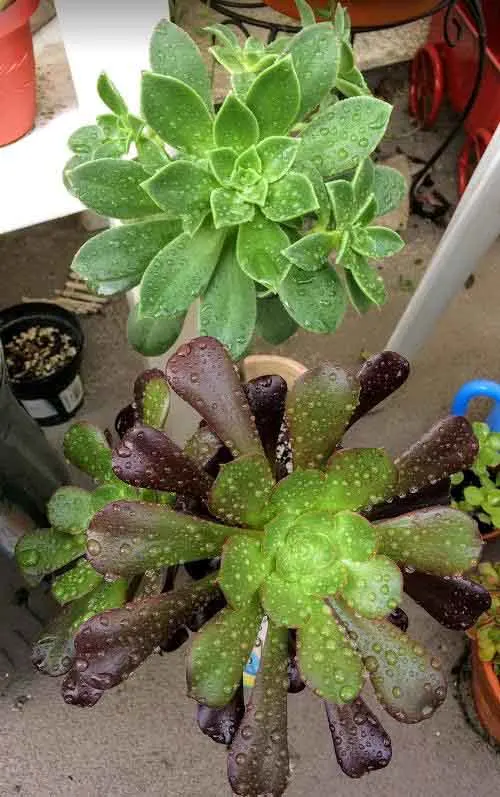
If you are misting instead of watering, the plant may not be getting enough water because the water may not be reaching the roots of the plant where the water needs to go to be absorbed.
Don’t be afraid to give the plant a good drink of water, let the water reach the roots of the plant so the plant can absorb it from the root up.
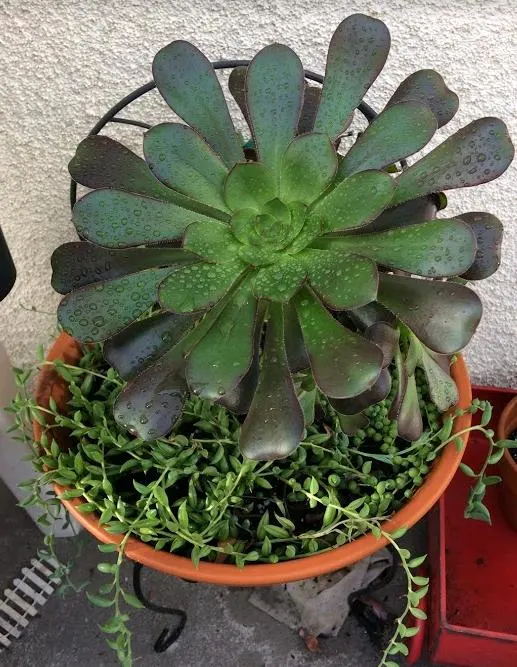
If you need further help with watering techniques, consider using tools like hygrometers or moisture meters to check for moisture in the soil and air.
These tools are pretty affordable and can come in handy when needed. Here are some moisture meters that I recommend.
Interested in finding out more about watering succulents? Visit my post “How And When To Water Succulents” where I go into details about this topic.
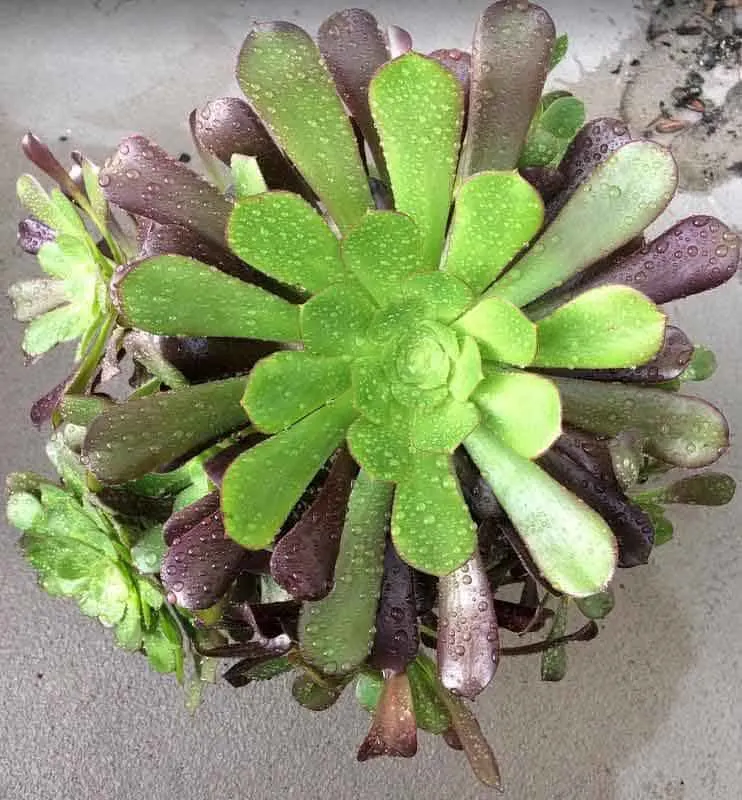
They sure love the rain and plump up right after. Here’s some pictures of my aeoniums after the rain.
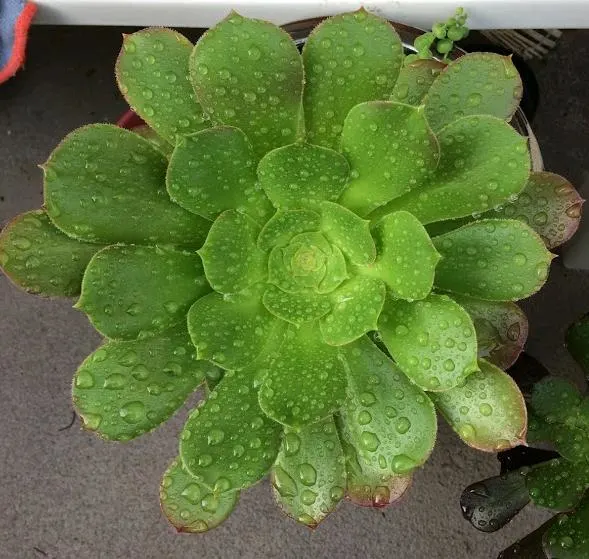
Outdoor Sunlight Requirements
Aeoniums can tolerate a wide range of sun exposure, from full sun to partial shade. Provide as much sunlight as you can. If you are planning to place the plant in full sun or if you want to increase sun exposure, you need to acclimate the plant to prevent sun damage to the leaves. Aeoniums that are not acclimated to intense sun will suffer from sunburn. Slowly increase the amount of sunlight until the plant becomes acclimated to full sun.
Even a mature plant that has been acclimated to full sun can still suffer from sunburn under a heatwave or extreme heat. During extreme heat or heat waves, even aeoniums that have been acclimated to full sun can suffer from sunburn. Provide sun shade or sun protection as needed or move to a shadier location. Here are some sun shades that I recommend that will help save your plants from extreme heat.
For further details and information on outdoor sunlight requirements, please visit my post “How Much Sunlight Do Succulents Need Outdoors?” to get some useful tidbits.
Indoor Lighting Requirements
If kept indoors, provide as much light as possible. Not enough light indoors coupled with too much water is a sure recipe for disaster for these plants. If you notice the plant etiolating or stretching and becoming leggy, it means the plant is not receiving enough and and is stretching out towards the sun to get more. Move the plant to a brighter location.
Generally, an east facing window as well as south or west facing are well tolerated. You may need to move the plant around a few times to find the right spot. If you are unable to provide adequate light indoors or if you have long, dark winters, consider using a growlight to keep your plants happy. Investing in a growlight will help keep your plants thriving indoors even if the quality of lighting is poor. Here are some growlights I recommend.
To read more about this topic on indoor lighting for succulents, check out my post on “Proper Lighting for Succulents Indoors” to get some helpful tips.
How to Make Aeoniums Branch Out
A unique feature of aeoniums is the way they grow and branch out. Aeoniums branch out from a single flowerhead to form new plants. Aeoniums branch out naturally as they grow and mature.
If you want yours to branch out, the easiest way I found is to take a stem cutting from a healthy plant and stick the stem cutting in soil. After a few weeks the stem cutting will root and as it grows and matures, it will start to branch out on its own. You will notice the flowerhead begin to warp as little baby plants emerge out of this single flower head.
Soon you will see this single stemmed flower head transforming into multiple branched out aeonium plants. When I first saw this happening I remember thinking the plant was looking more and more alien-like. Yes, it’s pretty awesome to behold.
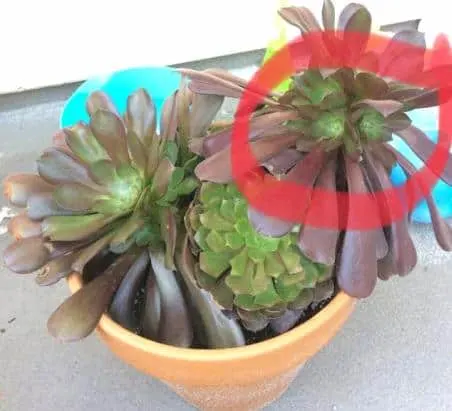
Do not expect an aeonium going through dormancy or a stressed aeonium to branch out. They typically branch out and grow vigorously during their active growing season. In my area, this typically happens during mid winter, coincidentally also when we get the most rain. Aeoniums start growing like crazy and branch out.
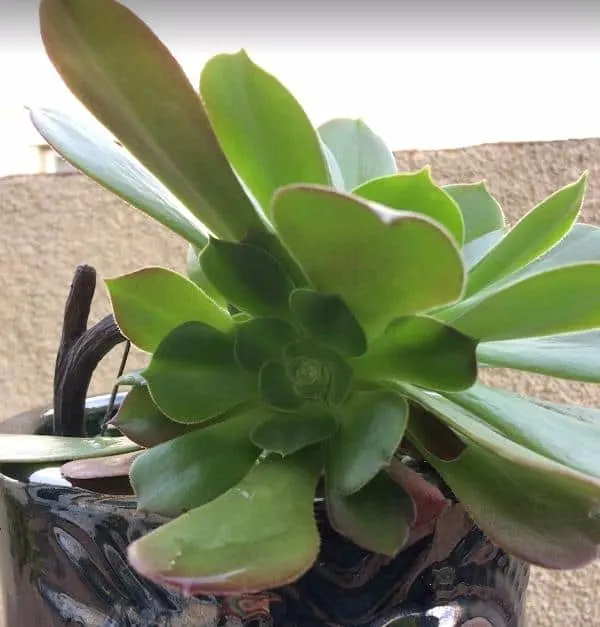
Here’s how aeoniums look when they branch out.
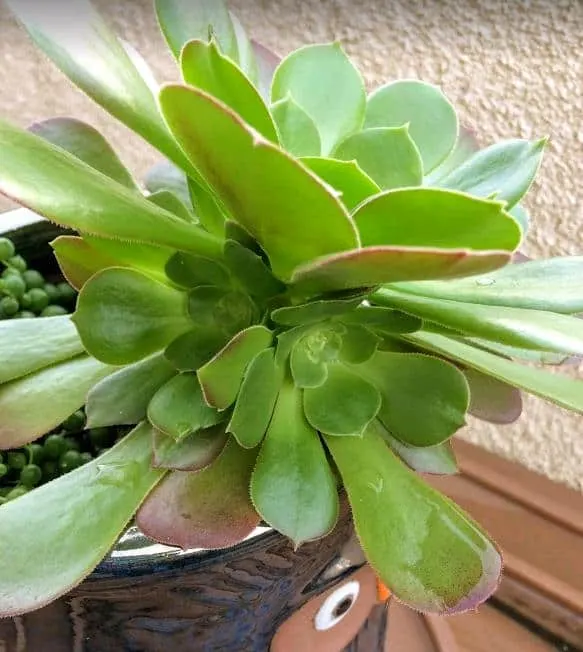
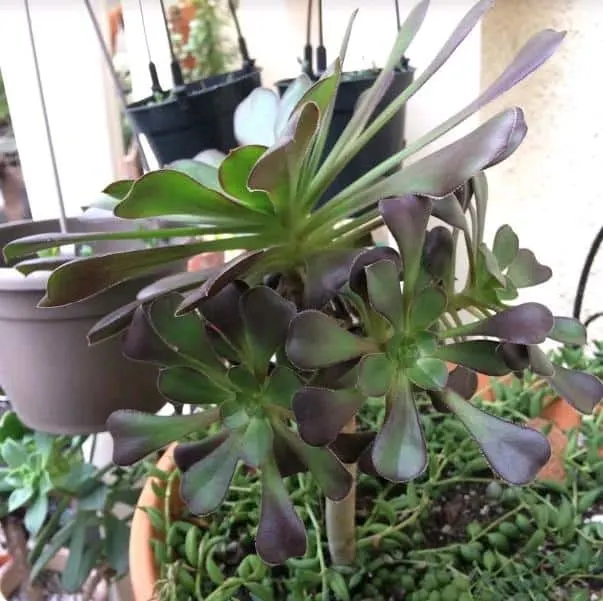
Why Do Aeonium Leaves Fall Off?
Aeoniums tend to drop or shed old leaves more so than other succulent plants. It is completely normal for aeoniums to drop old leaves as new ones develop. These leaves often appear wilted, dried up, brown and droopy. You can simply pull the old bottom leaves out or let them come off on their own.
Are You Underwatering and Overwatering?
Aeonium leaves can drop from underwatering and also overwatering. The plant sheds its leaves to conserve water and energy when it is underwatered. To correct this problem, give it a good drink and the plant should perk up almost immediately, within a day or so.
An overwatered aeonium will also shed its leaves from too much water. The plant will appear soggy and unwell. If the soil is kept constantly wet, root rot might set in and the plant will rot from the roots up. To prevent this, remove the plant from the wet soil and let it dry out for a few days. Replant in a well draining potting mix. Remove any parts that have rotted. Save the part of the stem that has not succumb to rot. The stem should feel firm and not mushy. You will be able to root the stem and propagate it to start a new plant.
Aeoniums During Dormancy
Aeoniums also shed their leaves when they go through dormancy or when they are under stress. They go dormant in the summer or during really hot and dry weather conditions, especially when left outdoors in the summer heat with very little water.
This is when you see the aeoniums shed a lot of the bottom leaves so that it seems as if most of the leaves are gone, and the rosettes close up. The stems will appear bare and scraggly. It may look as if the plant is dying but in reality the plant is just going through a dormant period. This is when the plant goes through a resting period.
Do not expect too much activity or growth from aeoniums during this period. Leave the plant alone at this time and avoid stressing the plant out by taking stem cuttings, repotting or propagating the plant. You may continue to water the plant as you normally would.
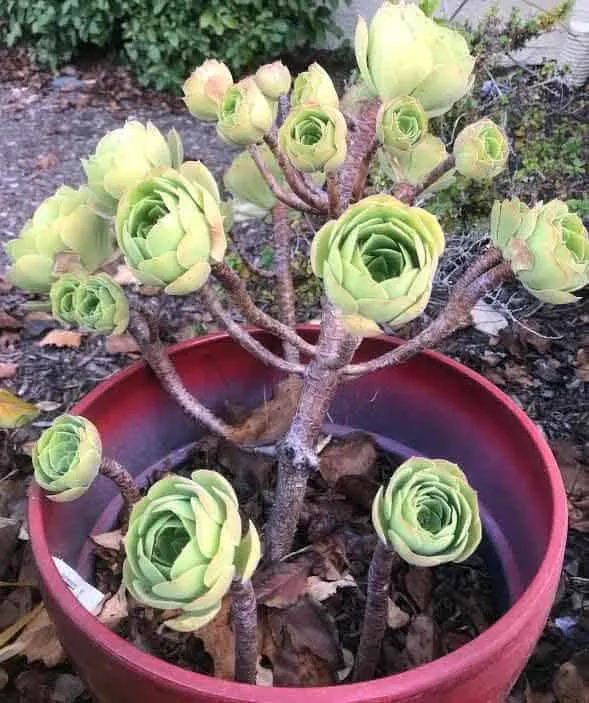
Some people refrain from watering altogether during dormancy but I still water the plant to prevent from completely drying out because the area I live in is extremely dry. Refrain from overwatering and refrain from fertilizing during dormancy. The plant does not need to be fed extra nutrients during this time.
Aeoniums during dormancy. They drop their bottom leaves and thin out.
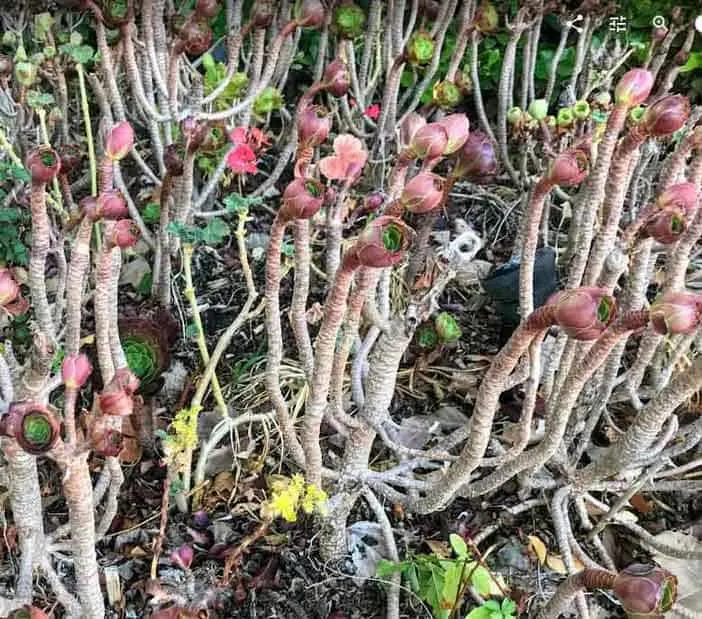
How to Root Aeoniums
Aeoniums are one of the most easiest succulent plants to root, in my opinion. I can attest to this by all the aeoniums I have rooted and propagated in the past. Simply take a stem cutting and if you want to see it root, just set it aside and keep it in a dry location away from direct sunlight. You will see roots forming from the bottom of the stem after about two weeks. It really is that simple. If you want to see faster results you can use a rooting hormone.
One thing I have never really tried is rooting aeonium leaves. But apparently, it can and has been tried and tested by many. The rule of thumb is, the thicker the aeonium leaves, the greater the success of it rooting. I have stuck with stem cuttings because they are so easy and almost foolproof, plus I get multiple plants eventually from a single stem cutting because of the way it branches out that I have never really attempted to root the leaves. But yes, if you are wondering if it’s possible, it apparently is.
How To Propagate Aeoniums Step-by-Step
- Take a leaf cutting (a whole leaf complete with the node) or a stem cutting.
- Let the leaf or stem dry for a day or two, more in humid locations. The thickness of the stem and humidity in your area will determine how the cuttings need to dry. As I mentioned above, I have never tried propagating aeoniums from leaves. Stem cuttings are my way to go because I find it easier, fool-proof and less time consuming. Leaf cuttings will take longer to grow into mature plants as they have more parts to grow.
- Dip in rooting hormone (optional step).
- Stick the stem cutting in a well draining soil. Stick the leaf cutting in soil or lay it on soil.
- Water the soil every few days or when dry and keep away from direct sunlight.
- After a few weeks, roots should have developed. You can check for roots by tugging at the plant. If the plant does not slide out of the soil easily then roots have formed and you have yourself and new plant that will soon grow, branch out and produce more aeoniums.
- Keep away from direct sunlight until fully rooted. Slowly increase the amount of light.
- Once mature, you can decrease watering as the plant becomes more drought tolerant.
Propagating aeoniums is really as simple as that.
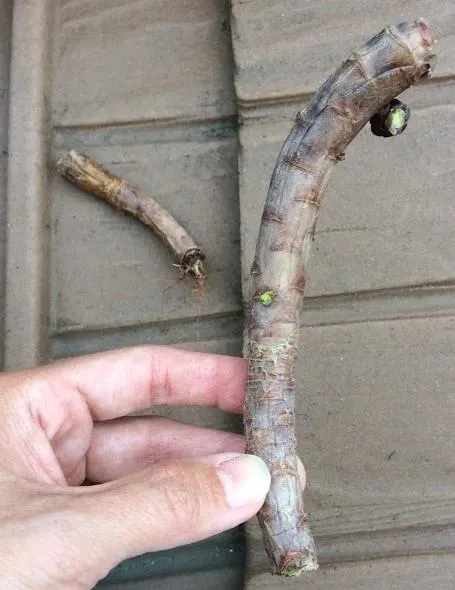
These are some of my stem cutting projects. This is my preferred route to propagate and multiply my aeonium collection.
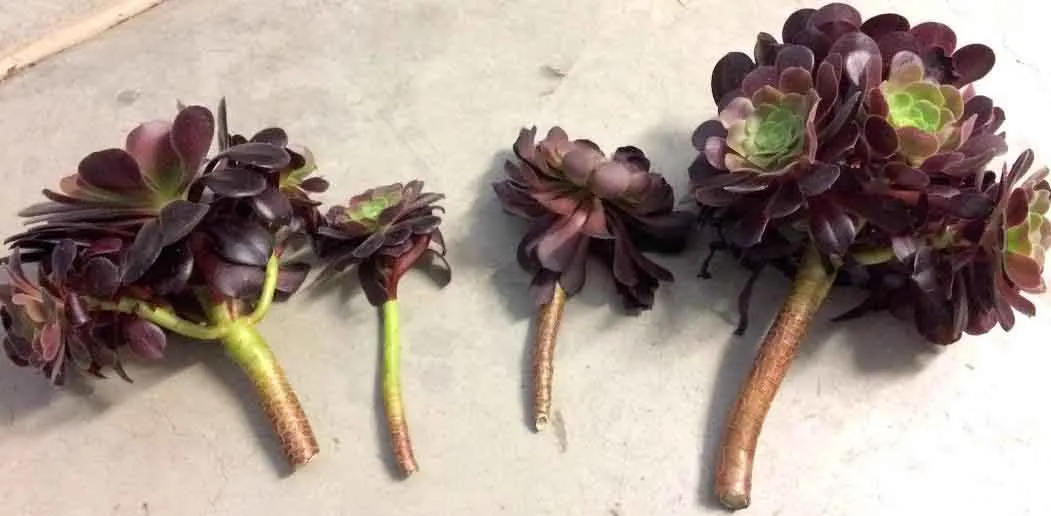
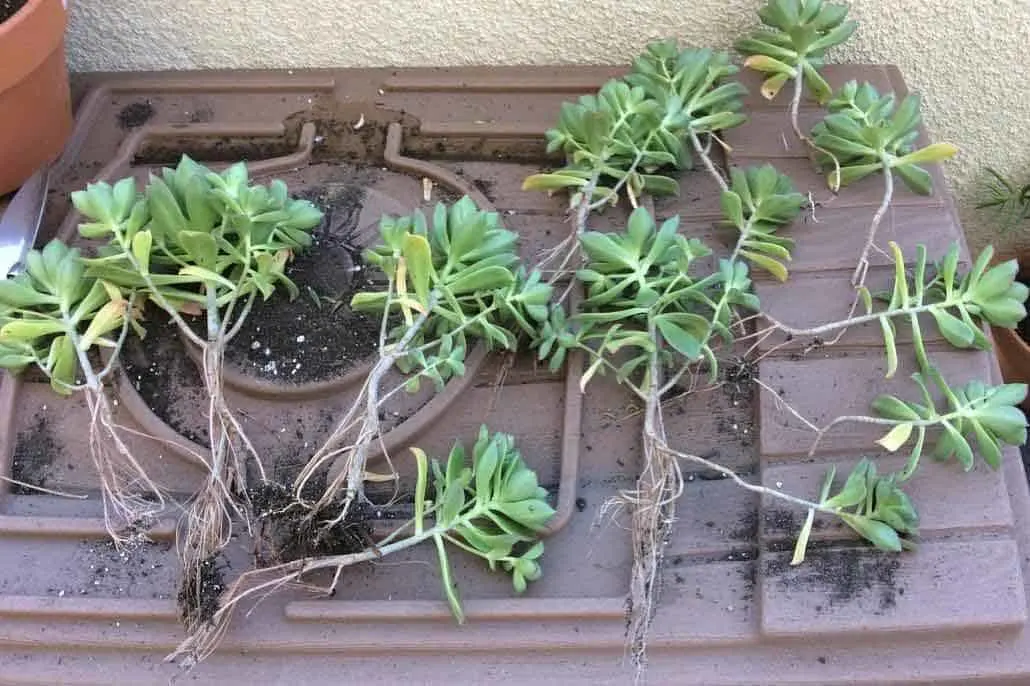
Water Propagation
Contrary to popular belief, you can successfully propagate succulents in water. Some people find water propagation to be easier than ‘dirt’ propagation. Water propagation is exactly that, using water as a medium to root succulent plants. I have tried a few experiments with water propagation using aeonium stem cuttings and other succulent plants and have had great success. To see how to propagate aeoniums in water step by step, read my posts “Water Propagation for Succulents” and “Does Water Propagation Work for Succulents”.
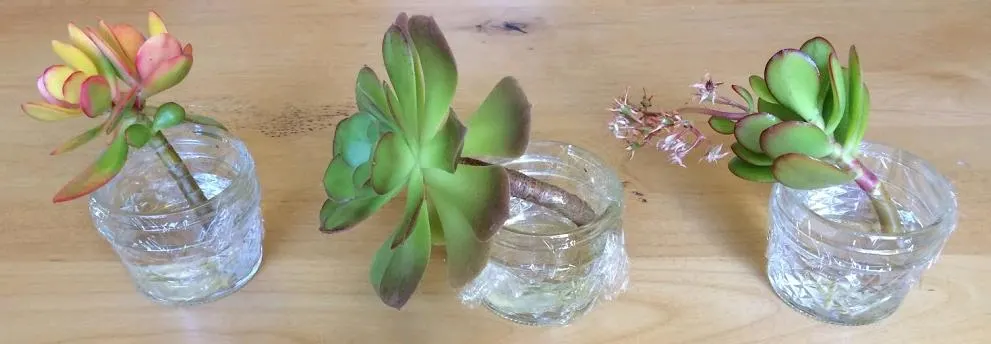
Aeoniums Are Monocarpic
Aeoniums produce elaborate flowers that shoot out from the center of the rosette. These flowers are not hard to miss. They are usually yellow in color and grow really tall.
Most aeonium species are monocarpic, meaning they die after flowering. Unfortunately, once you see an aeonium shoot out a bloom, there really isn’t much you can do to stop the process. However, aeoniums do not typically bloom until they have branched out and produced plenty of offsets.
The offsets that did not bloom will continue to live but the mother plant will die after blooming.
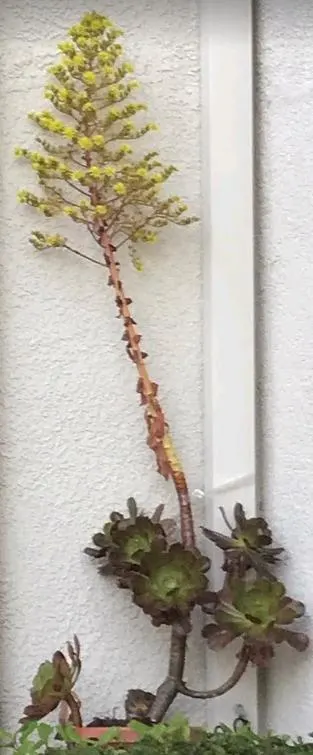
Are Aeoniums Poisonous to Dogs, Cats or Pets?
The ASPCA website does not list Aeonium species as toxic to pets. To learn more about toxic plants, visit ASPCA’s website. If you suspect poisoning, contact your local veterinarian immediately or the ASPCA Animal Poison Control Center at 888-426-4435.
Common Pests on Aeoniums
Aeoniums are not immune to common pests that bug succulents. Fortunately, they are resilient and hardy plants and can handle almost anything, even a bad infestation. Here are some common pests that can damage aeoniums:
Aphids (Greenflies or Plant Lice)–These are small insects with fat, teardrop-shaped bodies. They usually come colors green or black, but can come in other colors. They can be found sucking on leaves or flowers at the end of the stems, on the leaves and the undersides of the plant. They are known for the sugary white substance they secrete. This sugary substance can encourage the growth of black sooty mold.
How to Deal with Aphids:
Treat the plant with a mixture of soapy water. Add a few drops of dish soap in 1-2 cups of water and mix well. Spray onto infested areas and undersides of the leaves. You can also add vegetable oil to the soapy water. Put a few drops of dish soap in 1-2 cups of water with about 1 teaspoon of vegetable oil and mix well. Spray onto the infested areas where you see the bugs. Neem oil have also been used to treat and keep aphids away. Dilute 1 tablespoon or 15 ml of neem oil in 8 cups of water and mix well. Spray the solution onto infested areas and the undersides of the leaves. When using neem oil, do so at night to prevent burning your plant from sun damage.
Repeat treatment as necessary, about once a week, until the problem is resolved.
Mealybugs-Aeoniums are particularly susceptible to mealybugs. They are tiny and very easy to miss. An early sign your plants have mealybugs is the white cottony substance you see on your plants. Chances are you’ll spot these white fluff first before spotting the bugs. These insects secrete a sugary substance which can promote the growth of mold and make the plan more susceptible to bacterial and fungal infections. Mealybugs are slow moving insects and can be easily recognized and removed once you know what you are looking for. You can usually spot them on the leaves or the underside of leaves, and between the joints of the plant. They can easily spread from plant to plant.
How to Treat for Mealybugs: Use a cotton swab or Q-tip dipped in rubbing alcohol and apply directly on the bugs and anywhere you see the white cottony substance. Alternatively, you can use a spray bottle and spray rubbing alcohol directly onto the bugs and white fluff. Some people like to dilute the alcohol about half strength with water .
Instead of alcohol, you can also use soap such as dish soap diluted in water. Try using a few drops of soap in 2 cups of water and shake to mix well. Spray directly onto affected areas where you see the mealybugs and white fluff.
Repeat the treatment about once a week as needed until the problem is resolved. Isolate the infected plant to avoid contaminating your other plants as mealy bugs can spread from plant to plant.
Ants-Wherever mealybugs or aphids are, chances are you will find ants. Ants are not pestsbut when you see them all over your aeonium, you need to take a closer look because it is a sure sign that you have other pests hiding in your plants. That’s because ants farm these pests and use them as a food source. Aphids and mealybugs secrete honeydew or these sugary substance that ants love. Ants protect these pests and can transport them from one plant to another.
Remedy: Spray the plant with soapy water or insecticidal soap. Repeat as needed about once a week. You can also use ant baits near your plants to draw the ants away from your plant. Inspect the plant for other insects that are attracting the ants to the plants and treat as needed. Often, soapy water should help with the problem.
Tip: You need to get rid of the ants first before you can get rid of whatever pest infestation you may have, either aphids or mealybugs or something else. That’s because ants protect these pests and keep them around for as long as possible. Get rid of the ants first, then it will be easier to get rid of the pest infestation.
My aeoniums were hit hard by these garden pests two years ago. Thankfully, after some hard work, I got rid of them naturally without resulting to using harsh chemicals. My aeoniums are doing well these days and have remain bug free. These are very resilient plants and will usually bounce back when given a chance. Check out my post on “How to Treat Ants, Mealybugs, Aphids on Succulents” to get some useful tips on how to deal with these pests.
If you found this article helpful, I have another one on aeoniums that is just as informative. Please check it out to learn more about aeoniums: “Aeoniums Drooping, Leaves Dropping, Are My Aeoniums Dying?”
Where can you find Aeoniums? Check out my resource page for recommendations on where to purchase these and other succulent plants online.
Pin this post to save for later and to share with others!
